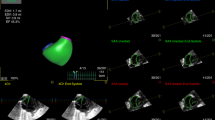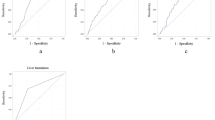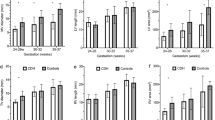Abstract
OBJECTIVE: To develop a predictive model using echocardiographic indices to identify nonsurvivors from survivors in preoperative patients with congenital diaphragmatic hernia (CDH).
STUDY DESIGN: Eight cases of CDH, with a mortality rate of 38%, underwent echocardiographic study before surgical repair. Left ventricular mass (LVMASS) using the area–length method of Wyatt et al. and fractional shortening (FS) by M-mode measurements were determined.
RESULTS: We identified a nonlinear nonoverlapping distribution that predicted nonsurvivors from survivors, p=0.04. Multiple regression analysis demonstrated the quantity (LVMASS×FS)1/2 to be correlated with nonsurvival with a coefficient of determination r2=0.55. Comparison of the means of the quantity (LVMASS×FS)1/2 for the two groups suggested two distinct populations, p=0.04.
CONCLUSION: The mathematical quantity (LVMASS×FS)1/2 calculated from echocardiographic measurements obtained preoperatively in babies with CDH may predict nonsurvival despite maximal intervention.
This is a preview of subscription content, access via your institution
Access options
Subscribe to this journal
Receive 12 print issues and online access
$259.00 per year
only $21.58 per issue
Buy this article
- Purchase on Springer Link
- Instant access to full article PDF
Prices may be subject to local taxes which are calculated during checkout

Similar content being viewed by others
References
Katz AL, Wiswell TE, Baumgart S . Contemporary controversies in the management of congenital diaphragmatic hernia Clin Perinatol 1998 Mar 25: 1 219–48
Flake AW, Ryckman FC . The neonatal gastrointestinal tract. Part Four: Selected anomalies and intestinal obstruction In: Fanaroff AA, Martin RJ, editors Neonatal–Perinatal Medicine. Diseases of the Fetus and Infant. 6th ed St Louis: Mosby 1997 p 1330–1
Schoeman L, Pierro A, Macrae D, Spitz L, Kiely EM, Drake DP . Late death after extracorporeal membrane oxygenation for congenital diaphragmatic hernia J Pediatr Surg 1999 Feb 349: 2 357–9
Nagaya M, Kato J, Niimi N, Tanaka S, Tanaka T . Analysis of patients with congenital diaphragmatic hernia requiring preoperative extracorporeal membrane oxygenation (ECMO) Pediatr Surg Int 1998 Nov 149: 1–2 25–9
Weber TR, Kountzman B, Dillon PA, Silen ML . Improved survival in congenital diaphragmatic hernia with evolving therapeutic strategies Arch Surg 1998 May 133: 5 498–502 discussion 502–3
Thibeault DW, Haney B . Lung volume, pulmonary vasculature, and factors affecting survival in congenital diaphragmatic hernia Pediatrics 1998 Feb 101: 2 289–95
Keshen TH, Gursoy M, Shew SB et al. Does extracorporeal membrane oxygenation benefit neonates with congenital diaphragmatic hernia? Application of a predictive equation J Pediatr Surg 1997 Jun 32: 6 818–22
Lessin MS, Thompson IM, Deprez MF, Cullen ML, Whittlesey GC, Klein MD . Congenital diaphragmatic hernia with or without extracorporeal membrane oxygenation: are we making progress? J Am Coll Surg 1995 Jul 181: 1 65–71
D'Agostino JA, Bernbaum JC, Gerdes M et al. Outcome for infants with congenital diaphragmatic hernia requiring extracorporeal membrane oxygenation: the first year J Pediatr Surg 1995 Jan 30: 1 10–5
Antunes MH, Greenspan JS, Cullen JA, Holt WJ, Baumgart S, Spitzer AR . Prognosis with preoperative pulmonary function and lung volume assessment in infants with congenital diaphragmatic hernia Pediatrics 1995 Dec 96: 6 1117–22
Albanese CT, Lopoo J, Goldstein RB et al. Fetal liver position and perinatal outcome for congenital diaphragmatic hernia Prenatal Diagn 1998 Nov 18: 11 1138–42
Lipschutz GS, Albanese CT, Feldstein VA et al. Prospective analysis of lung-to-head ratio predicts survival for patients with prenatally diagnosed congenital diaphragmatic hernia J Pediatr Surg 1997 Nov 32: 11 1634–6
Pusic AL, Giacomantonia M, Pippus K, Rees E, Gillis DA . Survival in neonatal congenital hernia without extracorporeal membrane oxygenation support JPediatr Surg 1995 Aug 30: 8 1188–90
Baumgart S, Paul JJ, Hubta JC et al. Cardiac malposition, redistribution of fetal cardiac output, and left heart hypoplasia reduce survival in neonates with congenital diaphragmatic hernia requiring extracorporeal membrane oxygenation J Pediatr 1998 July 133: 1 57–62
Wyatt H, Heng K, Meerbaum S et al. Cross-sectional echocardiography: I.Analysis of mathematic models for quantifying mass of the left ventricle in dogs Circulation 1979 60: 1104–13
Hewlett-Packard Ultrasound Systems equipment manual Palo Alto, CA: Hewlett-Packard, Inc
Moore K . The Developing Human 4th ed Philadelphia: Saunders 1988 p 166–7
Puri P, Wester T . Historical aspects of congenital diaphragmatic hernia Pediatr Surg Int 1997 Mar 21 12: 2/3 95–100
Germain JF, Farnoux C, Pinquier D et al. Can blood gas values predict pulmonary hypoplasia in antenatally diagnosed congenital diaphragmatic hernia? J Pediatr Surg 1996 Dec 31: 12 1634–9
Nobuhara KK, Wilson JM . Pathophysiology of congenital diaphragmatic hernia Semin Pediatr Surg 1996 Nov 5: 4 234–42
Kamata S, Usui N, Ishikawa S et al. Prolonged preoperative stabilization using high-frequency oscillatory ventilation does not improve the outcome in neonates with congenital diaphragmatic hernia Pediatr Surg Int 1998 Oct 13: 8 542–6
Wilson JM, Lund DP, Lillehei CW, Vacanti JP . Congenital diaphragmatic hernia: predictors of severity in the ECMO era J Pediatr Surg 1991 Sep 26: 9 1028–33 discussion 1033–4
Metkus AP, Esserman L, Sola A, Harrison MR, Adzick NS . Cost per anomaly: what does a diaphragmatic hernia cost? J Pediatr Surg 1995 Feb 30: 2 226–30
Finer NN, Barrington KJ . Nitric oxide in respiratory failure in the newborn infant Semin Perinatol 1997 Oct 21: 5 426–40
The Neonatal Inhaled Nitric Oxide Study Group (NINOS). Inhaled nitric oxide and hypoxic respiratory failure in infants with congenital diaphragmatic hernia Pediatrics 1997 Jun 99: 6 838–45
Author information
Authors and Affiliations
Rights and permissions
About this article
Cite this article
Cypher Springer, S., Fleming, D. & Hulsey, T. A Statistical Model to Predict Nonsurvival in Congenital Diaphragmatic Hernia. J Perinatol 22, 263–267 (2002). https://doi.org/10.1038/sj.jp.7210681
Published:
Issue Date:
DOI: https://doi.org/10.1038/sj.jp.7210681
This article is cited by
-
Heart Rate Variability as an Indicator of Outcome in Congenital Diaphragmatic Hernia With and Without ECMO Support
Journal of Perinatology (2004)
-
Pre-ECMO Predictors of Nonsurvival in Congenital Diaphragmatic Hernia
Journal of Perinatology (2002)



